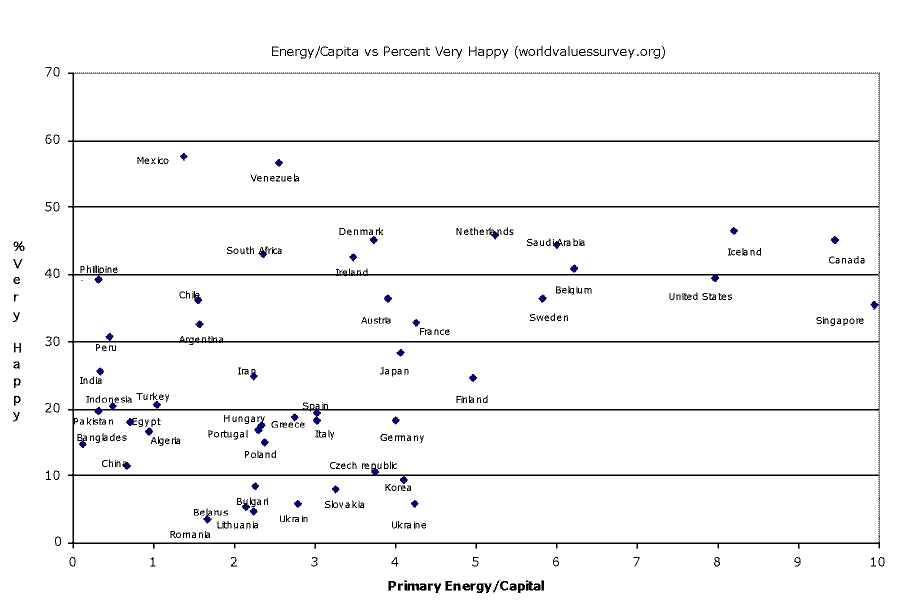Happiness and Energy Usage
Over at the Oil Drum, they look at the relationship between energy usage and happiness.
As can be seen, there is little correlation at all between subjective well being and energy use. (The actual r2 is 14%). Of note is the United States uses 39 times the primary energy as the Phillipines yet the percentage of the population that is `very happy' is about equal. While there is a low r2, this does not mean there is not a relationship.Of course this is based on the World Values Survey data for happiness and looks at those that self report being "very happy". Take this for what it is worth, as the accuracy of happiness studies is still suspect (Mexico and Venezuela are the happiest places to be??).
What about something more objective?
Vaclav Smil, in his book "Energy at the Crossroads" did similar work on objective measures of wellbeing vs energy consumption. A pattern similar to the above `boomerang' curve is found on comparisons of female longevity, sufficient nutritional food, educational opportunities, freedom etc. The shape is also the same, but inverted, for infant mortality. In general, Smil concludes that a reasonable level of well being on objective measures is achievable between 50 and 70 GJ/per capita, with marginal increases up to 100 GJ per capita. As a comparison, North America is currently at 340 GJ per capita. Again, the large excess consumption is not improving objective wellness.Sounds like a book I need to check out. 750 gallons of gasoline is approximately 100 GJ of energy.
From the article it appears that it is possible for the US to cut its energy use by 2/3 and still maintain its subjective and objective levels of well-being.





3 comments:
Back when I blogged, I'd blog for the idea that we can be healthy and happy even as we use less energy (and get more exercise). I'd rail against the hedonic treadmill (have I mentioned that here?)
If I haven't mentioned it here, I've found Stumbling on Happiness to be a fun and engaging book, which dovetails with the other reading I've done.
I recommend that to ... well, everyone really.
I wonder if the US provides some services to the world that no other country provides? I wonder if that is included in the figures you looked at?
Somebody may be comparing oranges to persimmons.
odograph,
I'm with you on the idea that we can be healthier and happier with less energy, and that we must be aware of the hedonic treadmill.
I read Stumbling on Happiness and liked it. You might also want to check out the The Happiness Hypothesis and The Paradox of Choice.
abhishek,
No thanks, but best of luck with your blog.
bill,
Good point. I doubt that this looks at "imports and exports" of energy. It is possible that the US uses energy to produce goods or provide services that are ultimately consumed somewhere else and this should really be attributed to the consuming country.
But, I think it is more likely that the US would consume more energy if this were taken into account. Much of China's energy use is in factories that are producing goods to be purchased in the US.
Post a Comment
Note: Only a member of this blog may post a comment.